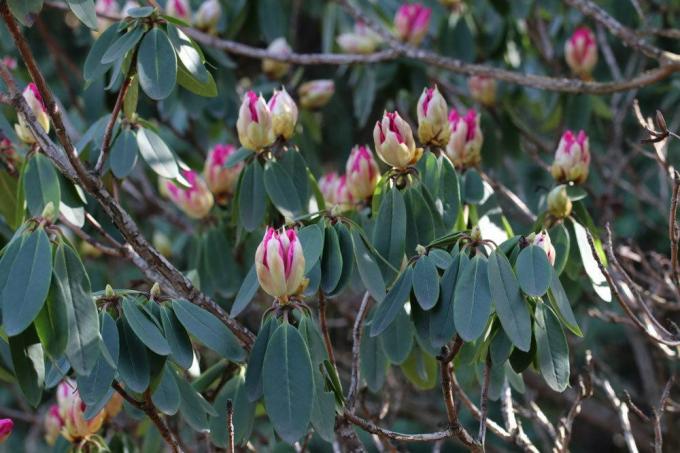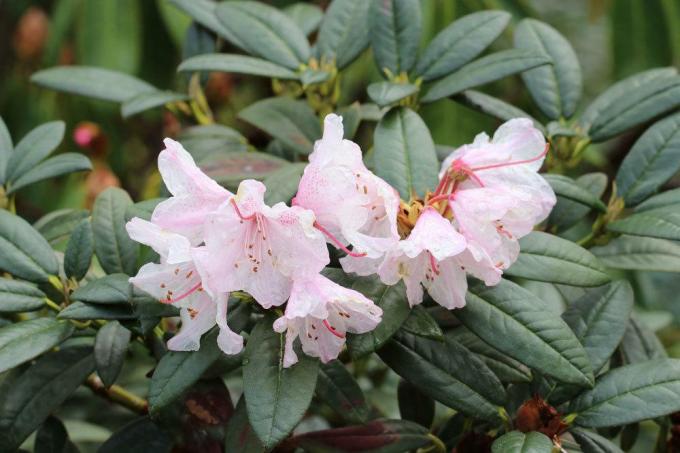
table of contents
- Optimal planting time for rhododendrons
- Advantages and disadvantages of spring planting
- Advantages and disadvantages of autumn planting
- Pay attention to
- The best time to change location
- frequently asked Questions
The growth of a plant depends largely on the weather conditions. For this reason, gardeners also need to rhododendron consider the ideal planting time.
In a nutshell
- year-round planting possible
- recommended planting time, especially in autumn
- Select the location carefully beforehand
- also suitable for planting in pots
Optimal planting time for rhododendrons
In the case of container goods, a rhododendron can be planted all year round. The only condition is a frost-free soil. The optimal time for root plants is more precisely defined. The gardener can choose between a spring planting (from March to May) or an autumn planting (from September to November). In principle, the latter method is more recommendable.

Advantages and disadvantages of spring planting
When planted in spring, the plant has enough time to form sufficient roots to show its frost resistance in winter. However, ground frosts can prevail until May and postpone the appropriate time. It is important that the planting into the ground takes place before the leaves emerge.
The rhododendron may have already bloomed by this time of year. In view of the enormous biodiversity, it is easy for the gardener to purchase the preferred flower color in stores.
Advantages and disadvantages of autumn planting
In early autumn, the gardener does not have to fear any ground frost. On the contrary, the earth has warmed up wonderfully and offers the plant the best conditions to establish itself in the new location. At this time of year, the heather plant develops its roots the fastest. It is already preparing for hibernation and therefore does not develop new shoots. The energy that the rhododendron needs to develop flowers and shoots in spring can now be fully invested in the root ball.
Pay attention to

Only in a suitable location does the plant delight with its abundant flowering and healthy growth. It makes comparatively high demands. All species are shallow-rooted and require a permeable, humus-rich soil. The pH value is in the best case 4.3 to 6. The planting depth is also very relevant. The root ball should be flush with the substrate layer.
It is essential to avoid a location in the blazing sun. On the other hand, a place on the north side of the property is suitable. Here it should be sheltered from the wind and slightly shaded. The rhododendron also feels at home under light trees.
After planting, the crop needs a lot of water. The water is not given regularly, but at longer intervals with increased amounts.
Note: The rhododendron makes considerable demands on its location. On the one hand, it requires a shady place, on the other hand, it only develops its blossoms in a reduced manner when it is too dark there.
The best time to change location
Has that Heather plant Once used to its location, transplanting is not necessary. But if it grows too high or shows poor growth due to unsuitable location conditions, the gardener should change location.

The optimal time corresponds to the above-mentioned planting time for the rhododendron. It is important that the floor is nice and warm. Between March and May as well as September and November the rhododendron is in the sap dormancy. For this reason, the changing location means no stress for the plant. In the year before, the gardener should refrain from pruning in order to prepare the plant for the measure.
Note: Normally, the gardener should wait to change location until the weather creates optimal conditions. However, if a disease or fungal attack makes transplanting necessary, the measure should be taken as soon as possible.
frequently asked Questions
If the garden offers no shade, the gardener can choose from alpine wild varieties or yakushimanum hybrids, which also thrive in the sun.
Unlike rhododendrons that grow outdoors, potted plants need winter protection. To do this, the gardener insulates the tub with a film and covers the plant with a fleece.


